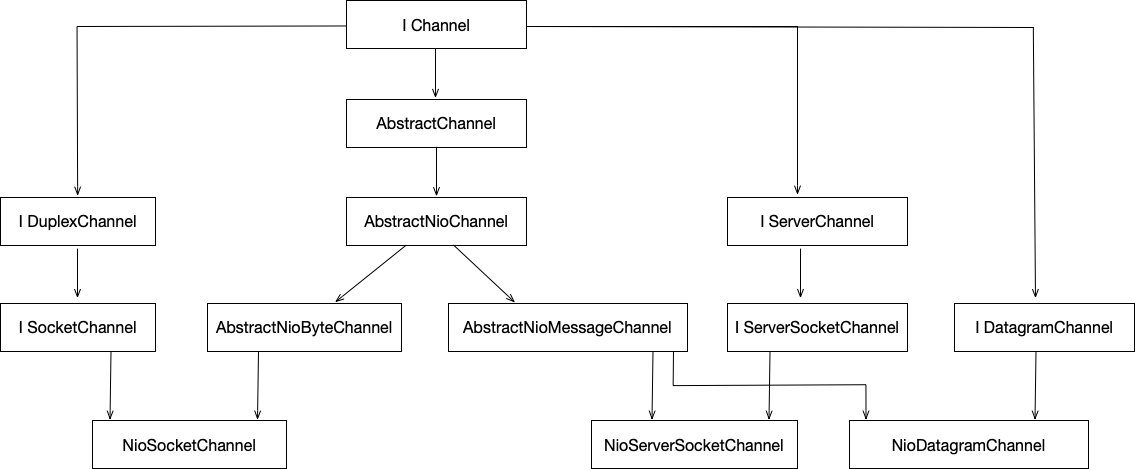netty源码解解析(4.0)-11 Channel NIO实现-概览
结构设计
Channel的NIO实现位于io.netty.channel.nio包和io.netty.channel.socket.nio包中,其中io.netty.channel.nio是抽象实现,io.netty.channel.socket.nio最终实现。下面是Channel NIO相关类的派生图:

NIO实现最终派生出3个类型NioServerSocketChannel实现了tcp server, NioSocketChannel实现了tcp client, NioDatagramChannel实现了udp socket。
整个NIO实现分为三个层次:
AbstractNioChannel抽象层
对channel进行基本的初始化工作,把channel设置成非阻塞模式。
实现Channel.Unsafe的connect方法框架,提供给了doConnection, doFinishConnect两个抽象方法,把真正的连接操作交给子类实现。
覆盖了AbstractChannel的doRegister,doDeregister方法,正两个方法实现了Channel的selectionKey的注册和注销。
实现AbstractChannel的doClose, 这个方法并没有真正关闭channel动作。
形如doXXX的方法是,AbstractChannel提供的扩展点,在<<netty源码解解析(4.0)-3 Channel的抽象实现>>的末尾,给出了这些扩展点的详细列表。
AbstractNioByteChannel, AbstractNioMessageChannel抽象层
这两个类主要实现read和write的框架,它们的实现大致相同AbstractNioByteChannel读写的是byte array,而AbstractNioMessageChannel读的时候会把byte array转换成结构化的对象,写的时候把结构化对象序列化成byte array。
AbstractNioByteChannel定义了3个抽象方法用来实现真正的读写操作: doReadBytes, doWriteBytes, doWriteFileRegion。
AbstractNioMessageChannel第了两个2个抽象方法用来实现真正的结构化数据类型的读写: doReadMessages, doWriteMessage。
NioServerSocketChannel, NioSocketChannel, NioDatagramChannel最终实现
封装NIO API调用,真正的I/O操操作和socket相关的api调用都在这一层实现。
使用方式
使用过netty的人都知道,netty提供了ServerBootstrap和Bootstrap类帮助用户方便地创建服务器端和客户端应用,但这不是必须的。仅仅使用NioServerSocketChannel, NioSocketChannel, NioDatagramChannel和NioEventLoopGroup就可以用开发tcp的server和client, 及udp应用。
为了能让读者能够更清晰地理解NioEventLoopGroup和Channel直接的关系,下面给出了最原始的使用使用netty框架的代码。
tcp server实现
import io.netty.buffer.ByteBuf;
import io.netty.channel.*;
import io.netty.channel.nio.NioEventLoopGroup;
import io.netty.channel.socket.nio.NioServerSocketChannel; import java.net.InetSocketAddress;
import java.nio.charset.Charset; public class TcpServer {
private NioEventLoopGroup group = new NioEventLoopGroup(); public static void main(String[] argc){
TcpServer server = new TcpServer();
server.start(); while(true){
try{
Thread.sleep(1000);
}catch (Exception e){
break;
}
} server.stop();
} public void start(){
NioServerSocketChannel server = new NioServerSocketChannel(); ChannelPipeline pipleline = server.pipeline();
pipleline.addFirst(new ServerHandler()); group.register(server).addListener(new ChannelFutureListener() {
@Override
public void operationComplete(ChannelFuture future) throws Exception {
server.bind(new InetSocketAddress(9001));
System.out.println("server listen add:"+9001);
}
});
}
public void stop(){
group.shutdownGracefully();
} private class ServerHandler extends ChannelInboundHandlerAdapter{ @Override
public void channelRead(ChannelHandlerContext ctx, Object msg) throws Exception{
Channel child = (Channel)msg; child.pipeline().addLast(new ChildHandler()); group.register(child); }
} private class ChildHandler extends ChannelInboundHandlerAdapter{ @Override
public void channelActive(ChannelHandlerContext ctx) throws Exception {
System.out.println("connected");
} @Override
public void channelInactive(ChannelHandlerContext ctx) throws Exception {
System.out.println("closed");
} @Override
public void channelRead(ChannelHandlerContext ctx, Object msg) throws Exception{
Channel chnl = ctx.channel();
ByteBuf data = (ByteBuf)msg; System.out.println("recv: "+data.toString(Charset.forName("utf-8")));
chnl.write(msg);
} @Override
public void channelReadComplete(ChannelHandlerContext ctx) throws Exception {
ctx.channel().flush();
} }
}
一个channel创建之后,首先要做的事就是向pipleline中添加handler,然后才是把它注册到NioEventLoopGroup中(第31,33行)。这个顺序不能错,否则,handler的handlerAdded,channelRegistered和channelActive将不会被调用。当NioServerSocketChannel收到一个连接时,ServerHandler的的channelRead方法将会被调用,的新建好的连接当成参数传递进来,第49-53行是对新连接的初始化代码。
tcp client实现
import io.netty.buffer.ByteBuf;
import io.netty.channel.*;
import io.netty.channel.nio.NioEventLoopGroup;
import io.netty.channel.socket.nio.NioSocketChannel; import java.net.InetSocketAddress;
import java.nio.charset.Charset; public class TcpClient { public static void main(String[] args){
NioEventLoopGroup group = new NioEventLoopGroup(); NioSocketChannel client = new NioSocketChannel();
client.pipeline().addLast(new ClientInboundHandler()); group.register(client); client.connect(new InetSocketAddress(9001)); try{
Thread.sleep(3000);
}catch (Exception e){ }
group.shutdownGracefully();
} private static class ClientInboundHandler extends ChannelInboundHandlerAdapter{
@Override
public void channelActive(ChannelHandlerContext ctx) throws Exception {
System.out.println("connected");
Channel chnl = ctx.channel();
ByteBuf buf = chnl.alloc().buffer();
buf.writeBytes( "this is test".getBytes());
chnl.writeAndFlush(buf);
} @Override
public void channelInactive(ChannelHandlerContext ctx) throws Exception {
System.out.println("closed");
} @Override
public void channelRead(ChannelHandlerContext ctx, Object msg) throws Exception{
ByteBuf data = (ByteBuf)msg;
System.out.println("recv: "+data.toString(Charset.forName("utf-8")));
ctx.channel().close();
}
} }
client的实现比server实现相对简单,添加handler,register顺序和server一致。只有把一个channel注册到gruop中之后才能调用它的方法,应为channel的大多数方法都需要通过pipleline调用,而pipleline需要在eventLoop中执行。
udp没有server和client的区别,这里为了使代码更加清晰,把server和client代码区分开来。
udp server
import io.netty.buffer.ByteBuf;
import io.netty.channel.*;
import io.netty.channel.nio.NioEventLoopGroup;
import io.netty.channel.socket.DatagramPacket;
import io.netty.channel.socket.nio.NioDatagramChannel; import java.net.InetSocketAddress;
import java.nio.charset.Charset; public class UdpServer { public static void main(String[] args){
NioEventLoopGroup group = new NioEventLoopGroup(); NioDatagramChannel chnl = new NioDatagramChannel();
chnl.pipeline().addLast(new UdpHandler()); group.register(chnl).addListener(new ChannelFutureListener() {
@Override
public void operationComplete(ChannelFuture future) throws Exception {
chnl.bind(new InetSocketAddress(9002));
System.out.println("udp bind at:"+9002);
}
}); while(true){
try{
Thread.sleep(1000);
}catch (Exception e){
break;
}
}
group.shutdownGracefully();
}
private static class UdpHandler extends ChannelInboundHandlerAdapter { @Override
public void channelActive(ChannelHandlerContext ctx) throws Exception {
System.out.print("udp channel active");
} @Override
public void channelRead(ChannelHandlerContext ctx, Object msg) throws Exception{
Channel chnl = ctx.channel();
DatagramPacket pkg = (DatagramPacket)msg;
ByteBuf content = pkg.content();
InetSocketAddress from = pkg.sender();
System.out.println("recv: "+content.toString(Charset.forName("utf-8"))+" from:"+from.toString());
pkg = new DatagramPacket(content, from);
chnl.write(pkg);
} @Override
public void channelReadComplete(ChannelHandlerContext ctx) throws Exception {
ctx.channel().flush();
}
}
}
udp client
import io.netty.buffer.ByteBuf;
import io.netty.channel.*;
import io.netty.channel.nio.NioEventLoopGroup;
import io.netty.channel.socket.DatagramPacket;
import io.netty.channel.socket.nio.NioDatagramChannel; import java.net.InetSocketAddress;
import java.nio.charset.Charset; public class UdpClient { public static void main(String[] args){
NioEventLoopGroup group = new NioEventLoopGroup(); NioDatagramChannel chnl = new NioDatagramChannel();
chnl.pipeline().addLast(new UdpHandler()); group.register(chnl).addListener(new ChannelFutureListener() {
@Override
public void operationComplete(ChannelFuture future) throws Exception {
chnl.bind(new InetSocketAddress(0));
}
}); try{
Thread.sleep(3000);
}catch (Exception e){
}
group.shutdownGracefully();
} private static class UdpHandler extends ChannelInboundHandlerAdapter { @Override
public void channelActive(ChannelHandlerContext ctx) throws Exception {
System.out.print("udp channel active");
Channel chnl = ctx.channel();
ByteBuf content = chnl.alloc().buffer();
content.writeBytes("udp message".getBytes());
chnl.writeAndFlush(new DatagramPacket(content, new InetSocketAddress("127.0.0.1", 9002)));
System.out.println("send message");
} @Override
public void channelRead(ChannelHandlerContext ctx, Object msg) throws Exception{
DatagramPacket pkg = (DatagramPacket)msg;
ByteBuf content = pkg.content();
InetSocketAddress from = pkg.sender();
System.out.println("recv: "+content.toString(Charset.forName("utf-8"))+" from:"+from.toString());
}
}
}
NioDatagramChannel和NioSocketChannel的初始化过程大致相同。它们的不同点是,NioSocketChannel在connect之后处于active状态,NioDatagramChannel是在bind之后处于才处于active状态。
netty源码解解析(4.0)-11 Channel NIO实现-概览的更多相关文章
- netty源码解解析(4.0)-14 Channel NIO实现:读取数据
本章分析Nio Channel的数据读取功能的实现. Channel读取数据需要Channel和ChannelHandler配合使用,netty设计数据读取功能包括三个要素:Channel, Eve ...
- netty源码解解析(4.0)-12 Channel NIO实现:channel初始化
创建一个channel实例,并把它register到eventLoopGroup中之后,这个channel然后处于inactive状态,仍然是不可用的.只有在bind或connect方法调用成功之后才 ...
- netty源码解解析(4.0)-15 Channel NIO实现:写数据
写数据是NIO Channel实现的另一个比较复杂的功能.每一个channel都有一个outboundBuffer,这是一个输出缓冲区.当调用channel的write方法写数据时,这个数据被一系列C ...
- netty源码解解析(4.0)-13 Channel NIO实现: 关闭和清理
Channel提供了3个方法用来实现关闭清理功能:disconnect,close,deregister.本章重点分析这个3个方法的功能的NIO实现. disconnect实现: 断开连接 disco ...
- netty源码解解析(4.0)-3 Channel的抽象实现
AbstractChannel和AbstractUnsafe抽象类 io.netty.channel.AbstractChannel 从本章开始,会有大量的篇幅涉及到代码分析.为了能够清晰简洁的地说明 ...
- netty源码解解析(4.0)-17 ChannelHandler: IdleStateHandler实现
io.netty.handler.timeout.IdleStateHandler功能是监测Channel上read, write或者这两者的空闲状态.当Channel超过了指定的空闲时间时,这个Ha ...
- netty源码解解析(4.0)-18 ChannelHandler: codec--编解码框架
编解码框架和一些常用的实现位于io.netty.handler.codec包中. 编解码框架包含两部分:Byte流和特定类型数据之间的编解码,也叫序列化和反序列化.不类型数据之间的转换. 下图是编解码 ...
- netty源码解解析(4.0)-10 ChannelPipleline的默认实现--事件传递及处理
事件触发.传递.处理是DefaultChannelPipleline实现的另一个核心能力.在前面在章节中粗略地讲过了事件的处理流程,本章将会详细地分析其中的所有关键细节.这些关键点包括: 事件触发接口 ...
- netty源码解解析(4.0)-20 ChannelHandler: 自己实现一个自定义协议的服务器和客户端
本章不会直接分析Netty源码,而是通过使用Netty的能力实现一个自定义协议的服务器和客户端.通过这样的实践,可以更深刻地理解Netty的相关代码,同时可以了解,在设计实现自定义协议的过程中需要解决 ...
随机推荐
- Powerdesigner数据库建模的浅谈
1.建立新模型 2.创建物理数据模型(可以选择数据库类型及版本) 3.建立表 左键点击Table这个图标,鼠标移动到空白工作区,再左键,一个表的视图就出来了,(连续左键,会出现多个表的视图),右键退出 ...
- centos7 安装maven
进入指定目录 cd /usr/local/src/ 下载maven 包 wget http://mirrors.hust.edu.cn/apache/maven/maven-3/3.1.1/bin ...
- 修改maven 本地仓库,加入阿里云
阿里云仓库服务 http://maven.aliyun.com/mvn/view maven加入阿里云服务 在maven conf文件下修改settings.xml 修改本地仓库<localR ...
- MFC禁用关闭按钮
有时候我们在写MFC程序时,需要在对话框中开启线程处理一些事情,如果在线程执行过程中点击关闭按钮,会导致程序崩溃. 这里介绍一种解决方法,禁用关闭按钮 解决方法 开启线程前禁用关闭按钮 CMenu* ...
- 位图法bitmap
1.概念 1)所谓bitmap,就是用每一位(bit)来标记某个元素对应的value, 而key即是该元素,通常bitmap是一个int数组,用每一个int数的每一个bit来映射某个数据 2)由于采用 ...
- shell脚本基础教程
一.什么是shell: shell解释:引用别人的话说:“Shell 是一个用 C 语言编写的程序,它是用户使用 Linux 的桥梁.Shell 既是一种命令语言,又是一种程序设计语言.” 简而言之, ...
- VS2017离线安装与Oracle数据库开发环境搭建
记得之前使用VS2015打开老的MVC4项目,不能右键创建控制器和添加视图,让我非常不习惯!找遍了网络无果,最后只能回到VS2013,但我就是不喜欢用旧的VS,这是不是病... 1.将VS2017离线 ...
- Codeforces gym102152 K.Subarrays OR
传送:http://codeforces.com/gym/102152/problem/K 题意:给定$n(n\le10^5)$个数$a_i(a_i\le10^9)$,对于任一个子数组中的数进行或操作 ...
- 分布式控制系统Git学习
git : n. 饭桶,无用的人 github : n. 社交编程及代码托管网站 hub: n. 中心:毂:木片 Git是一个分布式版本控制软件,最初由林纳斯·托瓦兹(Linus Torvalds)创 ...
- Python集成开发工具Pycharm的使用方法:复制,撤销上一步....
复制行,在代码行光标后,输入Ctrl + d ,即为复制一行,输入多次即为复制多行 撤销上一步操作:Ctrl + z 为多行代码加注释# 代码选中的条件下,同时按住 Ctrl+/,被选中行被注释,再 ...
